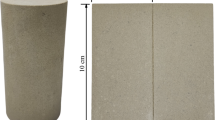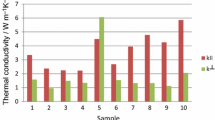Abstract
Strength and mechanical behavior of rocks and minerals are modified by aqueous environments. This results in two effects: mechanical and chemical. The chemical effect is investigated from both a theoretical and an experimental point of view. It is shown that a thermodynamic approach leads to a satisfactory understanding of the chemical effect through an ‘extended griffith concept’. Predictions of the model have been tested using slow crack growth experiments. The experiments have been performed with a special Double Torsion apparatus which was built for this purpose. The good agreement observed between theory and experiments suggests that subcritical crack growth in rocks is controlled by adsorption onto the crack tip. This result was previously suggested by other authors (Dunning et al., 1984). However, the important consequences of the model are that (1) there should exist a threshold stress below which subcritical crack growth stops, and this threshold depends on the environment; (2) subcritical crack growth and time-dependent phenomena could take place in the crust in a stress interval which could be as high as 50% of the rupture stress.
Similar content being viewed by others
References
Atkinson, B. K. (1984),Subcritical crack growth in geological materials. J. Geophys. Res.89, B6, 4077–4114.
Darot, M., Reuschlé, Th. andGuegen, Y. (1985a),Fracture parameter of Fontainebleau sandstones: experimental study using a high temperature controlled atmosphere Double Torsion apparatus. Research and Engineering Applications in Rock Masses, Ashworth Ed. (Belkema Rotterdam)
Darot, M., Gueguen, Y., Benchemam, Z. andGaboriaud, R. (1985b),Ductile fragile transition investigated by microindentation: results for quartz and olivine. Phys. Earth and Planet. Inter., 40, 180–186.
Dunning, J. D., Petrovski, D., Schuyler, J. andOwens, A. (1984),The effect of aqueous chemical environments on crack propagation in quartz. J. Geophys. Res.89, B6, 4115–4123.
Dunning, J. D., Lewis, W. L. andDurr, D. E. (1980),Chemomechanical weakening in the presence of surfactants. J. Geophys. Res.85, B10, 5344–5354.
Dunning, J. D. andHuf, W. L. (1983),The effect of aqueous chemical environments on crack and hydraulic fracture propagation and morphologies. J. Geophys. Res.88, B8, 6491–6499.
Ishido, T. andNishizawa, O. (1984),Effects of the Zeta potential on microcrack growth in rock under relatively low uniaxial compression. J. Geophys. Res.89, B6, 4153–4160.
Lawn, B. R. andWilshaw, T. R. (1975),Fracture of Brittle Solids (Cambridge University Press), 204pp.
Martin, R. andDurham, W. (1975),Mechanisms of crack growth in quartz, J. Geophys. Res.80, 4837–4844.
Maugis, D. (1985),Subcritical crack growth, surface energy and fracture toughness of brittle materials, Fracture Mechanics of ceramics, 7, Brodt, Evans, Hassalman and Lange, Eds. (Plenum Press).
Michalske, T. A. andFreiman, S. W. (1982),A molecular interpretation of stress corrosion in silica. Nature295, 511–512.
O'Keefe, M. andNavrotsky, A.,Structure and Bonding in Crystals (I). (Academic Press New York, 1981), 357pp.
Parks, G. A. (1984),Surface and interfacial free energies of quartz. J. Geophys. Res.89, B6, 3997–4008.
Peck, L., Nolen-Hoeksema, R. C., Barton, C. C. andGordon, R. B. (1985),Measurement of the resistance of imperfectly elastic rock to the propagation of tensile cracks. J. Geophys. Res.90, B9, 7827–7836.
Pletka, B. J. Fuller, Jr.,B. J. andKoepke, B. G. (1979),An evaluation of Double-Torison testing—Experimental fracture mechanics applied to brittle materials. Rep. ASTM STP 678, 19–37, Am. Soc. for Test. and Mater, Philadelphia, Pa.
Rice, J. R. (1978),Thermodynamics of the quasi-static growth of Griffith cracks. J. Mech. Phys. Solids26, 61–78.
Swalin, R. A.,Thermodynamics of Solids (Wiley, 1972), 387pp.
Swanson, P. L. (1984),Subcritical growth and other time-and environment-dependent behaviour in crustal rocks. J. Geophys. Res.89, 4137–4152.
Author information
Authors and Affiliations
Rights and permissions
About this article
Cite this article
Darot, M., Gueguen, Y. Slow crack growth in minerals and rocks: Theory and experiments. PAGEOPH 124, 677–692 (1986). https://doi.org/10.1007/BF00879604
Received:
Accepted:
Issue Date:
DOI: https://doi.org/10.1007/BF00879604




